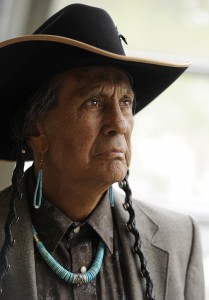Russell Means died Monday, October 22, just weeks before his 73rd birthday.
”¦“complex man”
Like all other leaders throughout history, Means was a complex man, hard to understand at those times when he seemed to be reckless or unaware of the effect he was having on those close to him.
”¦“single purpose..safeguard promises of treaties”¦”
Yet from a distance, he had an astonishingly brilliant character, unafraid above all, but also willing to put himself at the center of controversy. He seemed to have a single purpose ”“ to safeguard the promises of treaties with tribes, most especially his own Oglala Lakota nation ”“ but in a greater sense, all native people.
Rushmore and Mayflower Protests
Throughout his public life, which began in 1970 when he moved from San Francisco to Cleveland, Ohio and started his association with the American Indian Movement (AIM) Means only knew one direction: forward. In those days, there was strong interest in bringing the symbols of American history to the attention of the general public in a way that revealed the hundreds of years of pain and loss to the American Indian body and spirit those icons stood for. In 1970, he went to Mount Rushmore to take over that national monument and he went to Plymouth Rock to take over a replica of the Mayflower. Both of these takeovers were done to protest the treatment of Indian people.
Sovereignty and Spirituality
The 1960s was an era of protest and Indian protests had been going on, particularly those organized by the Tuscarora Mad Bear Anderson. He traveled to Cuba, moved against the State of New York, and proposed caravans to the nation”'s capital. But it was the charismatic Means who captured the attention of the press and other Indians to the cause of putting Indian sovereignty and spirituality at the center of a new national conversation.
He went to Washington, D.C. in 1971 as the national director of AIM and there he was able to study the organization of the Bureau of Indian Affairs (BIA), soon focusing on its Deputy Commissioner, John Old Crow, someone who had worked there since 1933. Old Crow received a career service award in 1964, yet six years later he was still at the top of the one governmental agency most responsible for the trust responsibility to Indian people. The Mohawk Louis R. Bruce was Commissioner, only the third Indian to hold the post. He followed the Oneida Robert Bennett and the celebrated Ely S. Parker, the only Indian to achieve the rank of General in the Civil War. Despite the fact that Louis Bruce was working hard to reform the BIA and he had hired bright young Indian professionals to help him do that, the face of the bureau from Russell Means”' perspective was of the old and tired John Old Crow, the immutable and immovable bureaucrat. AIM”'s strategy, was to perform a citizen”'s arrest on Old Crow. It didn”'t succeed, and trespass charges were made against the group of 24 Indians who were arrested. They were dropped the same day by Louis Bruce, and he invited the whole group over to his office for sandwiches and soft drinks. He listened to the issues brought forth and offered to look into them.
Partly in response to that, AIM brought Indians together from all over the country to formulate twenty reforms needed to bring true change. Those reforms were brought to Washington in 1972, just before Richard M. Nixon”'s second presidential election. Means was at the center of the occupation, urging those inside to be ready to make the ultimate sacrifice in the event a threatened armed police action was realized. Those inside had no weapons other than table legs and garbage can covers or chair seats for shields.
Wounded Knee
Wounded Knee in February 1973 tested Means”' leadership skills to the limit. The American military and the FBI placed the occupiers in their scopes. Air Force planes flew overhead. The threat of American armed action pinned the group down for 71 days. Food had to be flown in at great risk to the aiders. At the end, 1,200 arrests were made but almost no convictions resulted. Russell Means and Dennis Banks were charged but were released when Judge Fred J. Nichol ended the trial with severe admonitions to the FBI for its misconduct.
”¦“finest hour in Geneva”¦”
Then Means went on to his finest hour in Geneva, Switzerland in 1977 when the Declaration of Principles for the Defense of the Indigenous Nations and Peoples of the Western Hemisphere was drafted. That agreement, drawn up by the native peoples became the Declaration on the Rights of Indigenous Peoples in 2007. He became part of the history of the Western Hemisphere then, as perhaps no other Indian has done.
”¦“a way out from under”¦”
He never veered from his one true path: finding a way out from under the heavy boot of the United States on Indian sovereignty. He referred to the country as “the monster.” He could still teach Americans what they should know in such films as “Last of the Mohicans” or on cable as the hilarious gardener Wandering Bear on Larry David”'s show “Curb Your Enthusiasm.”
He was cremated and a 12-hour service was held at Little Wound High School Gymnasium in Kyle, South Dakota on Wednesday, October 24. His ashes were scattered in the Black Hills the following day.
Laura Waterman Wittstock  is an elder with exceptional knowledge and wisdom having vast accomplishments locally and nationally; for example the Farr Award for “exceptional contribution to public affairs journalism” and is Producer of “First Person Radio”–KFAI-FM with interviews on topics affecting Native people.










